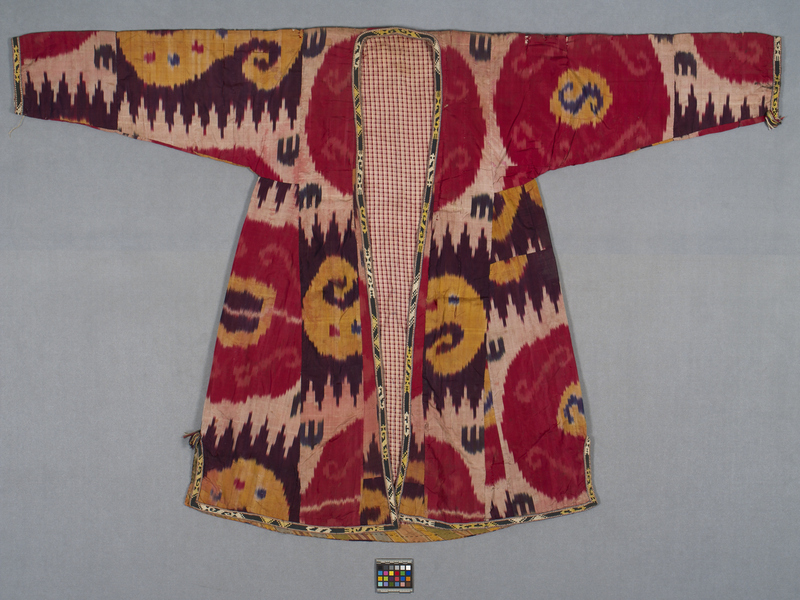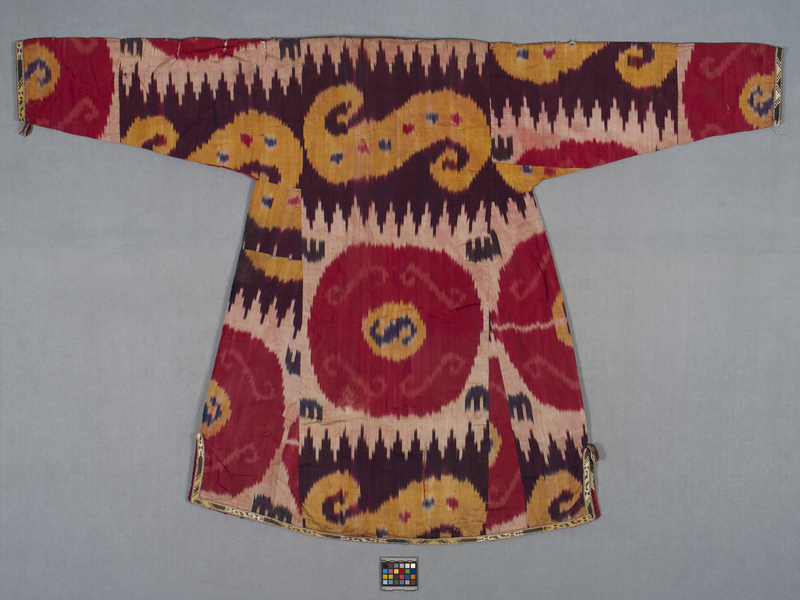Coat Item Number: 3231/16 from the MOA: University of British Columbia


Description
Man's full-length, quilted, A-line, silk robe or coat, open at the front with no closures, has long tapered sleeves. Warp ikat textile, with red, yellow and purple predominating, on a pinkish background; silk warp and red silk weft, giving the textile a pale pinkish colour; large circular sun motifs, curved motifs called ‘bodom’ and ram’s horns motifs. Trimmed on all edges with dark green, yellow, off-white and orange tablet-woven braid; 16 cm vertical vents at the hemline on each side. The body of the robe is lined with dark red and off-white checked cotton textile; sleeves are lined with printed cotton textile, with red and brown floral designs on an off-white background. The front edges are faced with bias-cut strips of dark red cotton textile; the back edges are faced with bias strips of pastel multicoloured cotton textile. Light weight cotton batting between the outer textile and the lining.
History Of Use
Ikat robes were worn by men, women and children of various cultures. Women’s robes incorporate extra fullness under the armholes, for wearing ease, and the front opening is typically wide at the chest area, in order to show the lavish jewelry that women often wore. Robes were worn on top of a shirt, tunic or dress and with wide drawstring pants. Several robes may have been worn at once, layered one over another, to display rank and/or wealth. The colourful printed cotton textiles which were typically used to line robes were manufactured in Russia for the Central Asian market, as was the striped bias-cut cotton textile that was used as facings on all the edges (called the lapse). Following the Russian Revolution, the workshops that made ikat robes like this one, which had been organized around family and social networks, were disbanded by the Soviet government, replaced by collective practices in factories. Eventually the making and wearing of ikat robes disappeared.
Narrative
Joanna Staniszkis purchased this robe and most other robes in the 3231 accession in Istanbul, shortly after the dissolution of the USSR; the robes had been previously stored in trunks for a considerable length of time.
Iconographic Meaning
The decorative braid or embroidery on all outside edges of ikat robes was believed to be an essential part of the garment, as it prevented evil spirits from infecting the wearer.
Specific Techniques
Hand woven warp-ikat technique.
Item History
- Made in Uzbekistan ? before 1900
- Collected in Istanbul, Turkey during 1991
- Owned by Joanna Staniszkis before March 20, 2017
- Received from Joanna Staniszkis (Donor) on March 20, 2017
What
- Name
- Coat
- Identification Number
- 3231/16
- Type of Item
- coat
- Material
- silk fibre, indigo dye, safflower dye ?, madder root dye and wool fibre
- Manufacturing Technique
- hand woven warp-ikat
- Overall
- height 117.0 cm, width 175.0 cm
Who
- Culture
- Uzbek ?
- Previous Owner
- Joanna Staniszkis
- Received from
- Joanna Staniszkis (Donor)
Where
- Holding Institution
- MOA: University of British Columbia
- Made in
- Uzbekistan ?
- Collected in
- Istanbul, Turkey
When
- Creation Date
- before 1900
- Collection Date
- during 1991
- Ownership Date
- before March 20, 2017
- Acquisition Date
- on March 20, 2017
Other
- Item Classes
- textiles
- Condition
- fair
- Accession Number
- 3231/0016